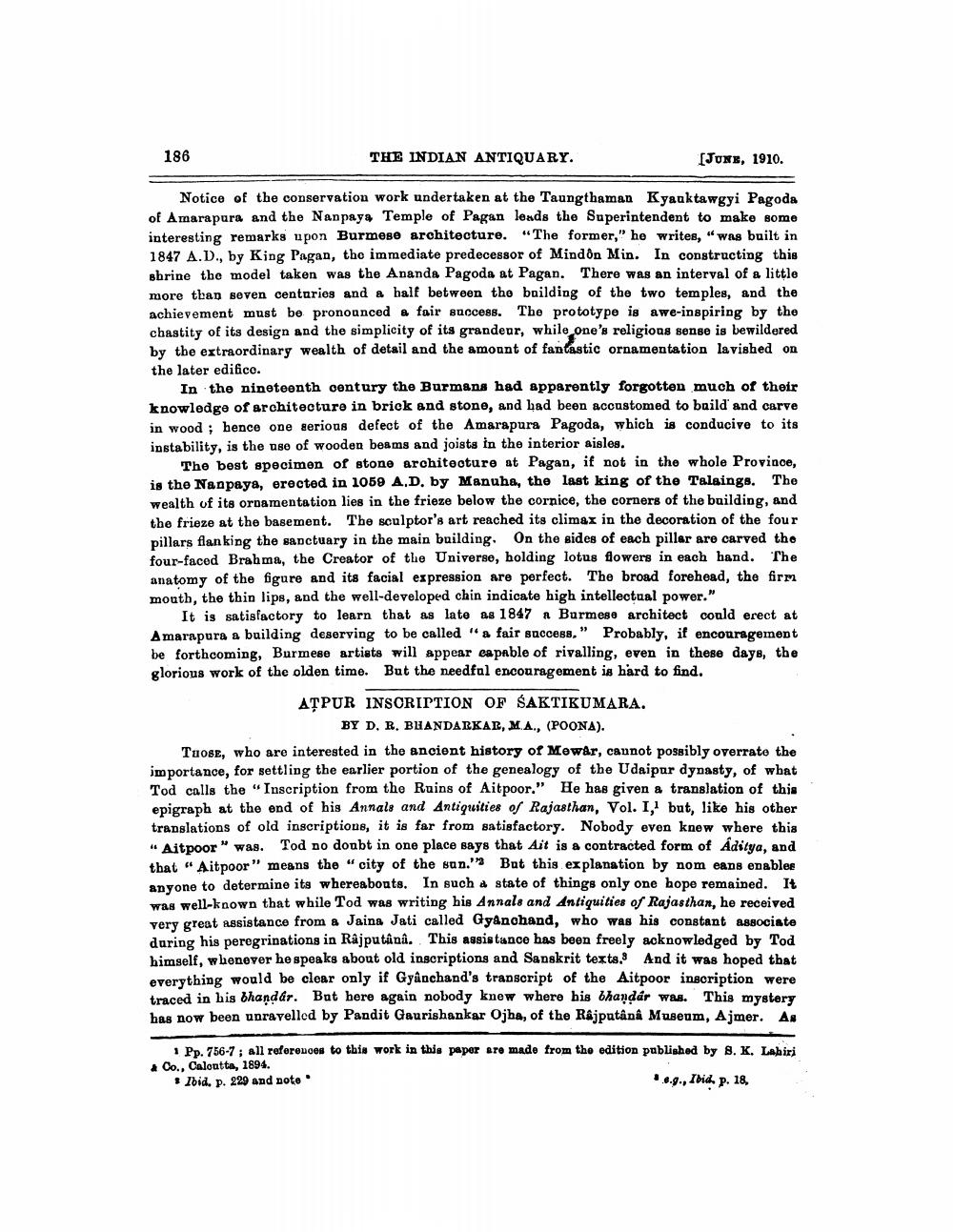________________
THE INDIAN ANTIQUARY.
[JUNE, 1910.
Notice of the conservation work undertaken at the Taungthaman Kyauktawgyi Pagoda of Amarapura and the Nanpaya Temple of Pagan leads the Superintendent to make some interesting remarks upon Burmese architecture. "The former," he writes, "was built in 1847 A.D., by King Pagan, the immediate predecessor of Mindôn Min. In constructing this shrine the model taken was the Ananda Pagoda at Pagan. There was an interval of a little more than seven centuries and a half between the building of the two temples, and the achievement must be pronounced a fair success. The prototype is awe-inspiring by the chastity of its design and the simplicity of its grandeur, while one's religious sense is bewildered by the extraordinary wealth of detail and the amount of fantastic ornamentation lavished on the later edifico.
186
In the nineteenth century the Burmans had apparently forgotten much of their knowledge of architecture in brick and stone, and had been accustomed to build and carve in wood; hence one serious defect of the Amarapura Pagoda, which is conducive to its instability, is the use of wooden beams and joists in the interior aisles.
The best specimen of stone architecture at Pagan, if not in the whole Province, is the Nanpaya, erected in 1059 A.D. by Manuha, the last king of the Talaings. The wealth of its ornamentation lies in the frieze below the cornice, the corners of the building, and the frieze at the basement. The sculptor's art reached its climax in the decoration of the four pillars flanking the sanctuary in the main building. On the sides of each pillar are carved the four-faced Brahma, the Creator of the Universe, holding lotus flowers in each hand. The anatomy of the figure and its facial expression are perfect. The broad forehead, the firm mouth, the thin lips, and the well-developed chin indicate high intellectual power."
It is satisfactory to learn that as late as 1847 a Burmese architect could erect at Amarapura a building deserving to be called "a fair success. "Probably, if encouragement be forthcoming, Burmese artists will appear capable of rivalling, even in these days, the glorious work of the olden time. But the needful encouragement is hard to find.
ATPUR INSCRIPTION OF SAKTIKUMARA.
BY D. R. BHANDARKAR, M.A., (POONA).
Tuose, who are interested in the ancient history of Mewar, cannot possibly overrate the importance, for settling the earlier portion of the genealogy of the Udaipur dynasty, of what Tod calls the "Inscription from the Ruins of Aitpoor." He has given a translation of this epigraph at the end of his Annals and Antiquities of Rajasthan, Vol. I, but, like his other translations of old inscriptions, it is far from satisfactory. Nobody even knew where this "Aitpoor" was. Tod no doubt in one place says that Ait is a contracted form of Aditya, and that "Aitpoor" means the "city of the sun. But this explanation by nom eans enables anyone to determine its whereabouts. In such a state of things only one hope remained. It was well-known that while Tod was writing his Annals and Antiquities of Rajasthan, he received very great assistance from a Jaina Jati called Gyanchand, who was his constant associate during his peregrinations in Rajputânâ. This assistance has been freely acknowledged by Tod himself, whenever he speaks about old inscriptions and Sanskrit texts. And it was hoped that everything would be clear only if Gyânchand's transcript of the Aitpoor inscription were traced in his bhandar. But here again nobody knew where his bhandar was. This mystery has now been unravelled by Pandit Gaurishankar Ojha, of the Rajputânâ Museum, Ajmer. As
1 Pp. 756-7; all references to this work in this paper are made from the edition published by 8. K. Lahiri a Co., Caloutta, 1894.
Ibid. p. 229 and note
e.g., Ibid. p. 18,




